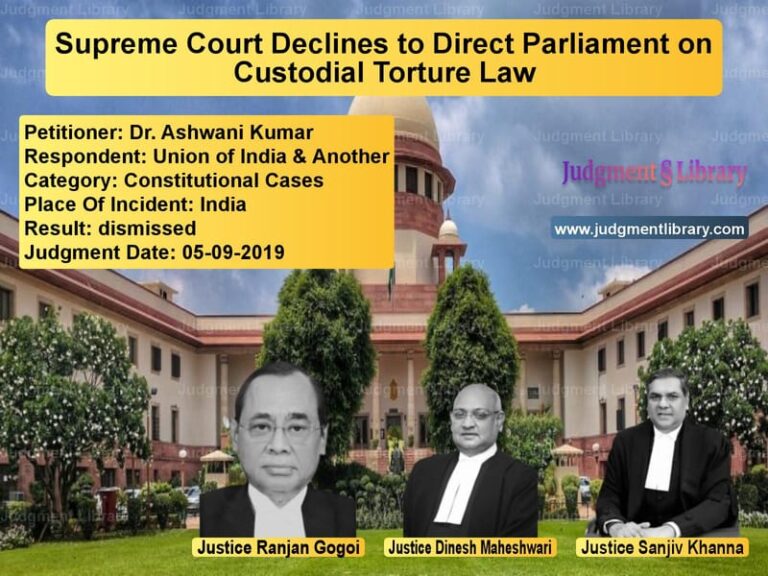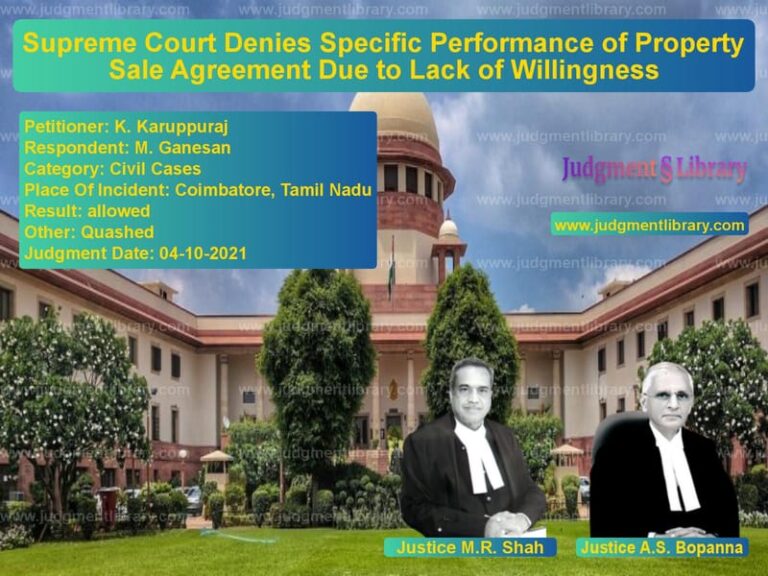Supreme Court Quashes Conviction in Dowry Death Case: Legal Precedents and Court’s Rationale
The Supreme Court of India recently delivered a significant judgment in the criminal appeal of Karan Singh v. State of Haryana, where the appellant, Karan Singh, sought to overturn his conviction for dowry death and cruelty under Sections 304-B and 498-A of the Indian Penal Code (IPC). The judgment quashes both convictions and acquits Karan Singh, setting a legal precedent for the application of dowry death laws and the standards of evidence required in such cases.
The case involves the death of Karan Singh’s wife, Asha Rani, who allegedly died by suicide after enduring cruelty and harassment over dowry demands. The Sessions Court convicted Karan Singh for both dowry death and cruelty. However, the Supreme Court found significant gaps in the prosecution’s case, particularly in terms of the evidence presented to establish that the death was a dowry death or caused by the appellant’s cruelty.
Background of the Case
The appellant, Karan Singh, married Asha Rani on June 25, 1996. After their marriage, Asha Rani allegedly faced physical and emotional abuse due to insufficient dowry. On April 2, 1998, Asha Rani was found dead by hanging, and the postmortem report confirmed death by asphyxia. The prosecution’s case was built around the allegations that the appellant had subjected Asha Rani to cruelty, leading to her suicide, and that this fell under the provisions of dowry death under Section 304-B of IPC.
Witnesses, including the deceased’s family members (PW-6, PW-7), testified that the appellant had demanded dowry and subjected Asha Rani to harassment. The prosecution claimed that shortly before her death, Asha Rani had revealed to her family members that Karan Singh had demanded money for purchasing a jeep and had physically abused her.
The Sessions Court convicted Karan Singh based on the testimonies of the deceased’s family members, primarily PW-6 (the mother of the deceased) and PW-7 (the brother of the deceased). However, the High Court’s judgment was challenged on appeal due to gaps in the evidence and contradictions in the statements of the witnesses.
Key Legal Issues
- Whether the death of Asha Rani was a dowry death under Section 304-B of IPC and whether the appellant was responsible for it.
- Whether the testimonies of the deceased’s family members, including the mother (PW-6) and brother (PW-7), were credible and sufficiently corroborated by other evidence.
- Whether the legal requirements under Section 304-B for proving dowry death were met, especially with respect to the evidence of cruelty or harassment before the death.
- The application of the presumption under Section 113-B of the Indian Evidence Act, 1872, and whether it applied in this case.
Arguments of the Parties
Petitioner’s Arguments
The appellant, Karan Singh, represented by his counsel, argued the following points:
- The allegations of dowry harassment were based on hearsay and were not substantiated by any material evidence.
- There was no direct evidence linking him to the alleged cruelty or harassment, and the witnesses’ statements were inconsistent and contradictory.
- The statements made by the deceased’s family members regarding dowry demands and physical abuse were omissions in their earlier police statements, casting doubt on their veracity.
- In the absence of any conclusive proof or direct evidence, the Sessions Court erred in convicting him under Section 304-B and Section 498-A of IPC.
Respondents’ Arguments
The respondents, represented by the State of Haryana, contended the following:
- The evidence of PW-6 and PW-7 clearly established that the deceased was subjected to continuous cruelty and harassment due to dowry demands, and this led directly to her death.
- Testimonies from family members and witnesses corroborated the claims of dowry harassment and established a clear link between the cruelty and the tragic death of Asha Rani.
- The appellant’s refusal to accept responsibility for the death and the contradictory statements he made during the investigation were enough to uphold the conviction under both Section 304-B and Section 498-A of IPC.
Supreme Court’s Observations
The Supreme Court carefully examined the legal provisions and the facts of the case. It made the following critical observations:
“The prosecution’s case is based entirely on circumstantial evidence, and there is a clear lack of corroboration in the testimonies of the witnesses. In particular, PW-6’s statement about dowry harassment is not corroborated by her earlier police statements. Similarly, PW-7’s testimony regarding physical abuse is vague and not supported by any concrete evidence.”
The Court also pointed out that the testimonies of the deceased’s family members contained contradictions and omissions. Furthermore, the prosecution had failed to establish that the appellant’s actions were directly linked to the deceased’s suicide, which is crucial to proving a dowry death under Section 304-B of IPC.
On the issue of Section 113-B of the Indian Evidence Act, the Court observed that the presumption of dowry death could not be applied in this case, as the prosecution had failed to provide sufficient evidence of dowry harassment or cruelty immediately before the death.
Final Judgment and Directions
The Supreme Court ruled in favor of the appellant, quashing both the conviction and the sentence. The Court held that:
- The evidence presented by the prosecution, particularly the testimonies of PW-6 and PW-7, was insufficient to establish a case for dowry death or cruelty under IPC.
- The prosecution had failed to prove that the appellant had subjected the deceased to cruelty or harassment in connection with any demand for dowry.
- The charge under Section 304-B for dowry death was not made out, and the appellant’s conviction was set aside.
- The appeal was allowed, and the appellant was acquitted of all charges.
Implications of the Judgment
This ruling underscores the importance of solid, corroborated evidence in dowry death and cruelty cases. The Court’s decision to acquit the appellant highlights that the presumption under Section 113-B of the Evidence Act cannot be invoked in the absence of reliable evidence proving cruelty or harassment related to dowry demands. The judgment also reiterates the importance of consistency in witness testimony and the need for the prosecution to provide clear, direct evidence to support allegations of dowry-related violence or harassment.
Conclusion
The Supreme Court’s ruling in Karan Singh v. State of Haryana serves as an important precedent in dowry death cases, reinforcing the need for robust evidence to support accusations of dowry-related cruelty. This judgment will be pivotal in ensuring that allegations of dowry harassment are not taken lightly and must be supported by clear and consistent evidence before a conviction can be sustained. It also serves as a reminder of the critical role of witness testimony and the legal standards required to prove guilt beyond a reasonable doubt in criminal cases.
Petitioner Name: Karan Singh.Respondent Name: State of Haryana.Judgment By: Justice Abhay S. Oka, Justice Ujjal Bhuyan.Place Of Incident: Haryana.Judgment Date: 31-01-2025.
Don’t miss out on the full details! Download the complete judgment in PDF format below and gain valuable insights instantly!
Download Judgment: karan-singh-vs-state-of-haryana-supreme-court-of-india-judgment-dated-31-01-2025.pdf
Directly Download Judgment: Directly download this Judgment
See all petitions in Bail and Anticipatory Bail
See all petitions in Criminal Defamation
See all petitions in Workplace Harassment
See all petitions in Judgment by Abhay S. Oka
See all petitions in Judgment by Ujjal Bhuyan
See all petitions in dismissed
See all petitions in Quashed
See all petitions in supreme court of India judgments January 2025
See all petitions in 2025 judgments
See all posts in Criminal Cases Category
See all allowed petitions in Criminal Cases Category
See all Dismissed petitions in Criminal Cases Category
See all partially allowed petitions in Criminal Cases Category







